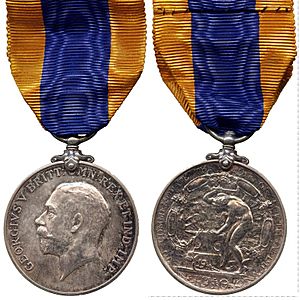Union of South Africa Commemoration Medal facts for kids
Quick facts for kids Union of South Africa Commemoration Medal |
|
|---|---|
 |
|
| Country | |
| Type | Commemorative medal |
| Eligibility | Military and civil leaders |
| Awarded for | Commemoration of the opening of the first Union Parliament |
| Statistics | |
| Established | 1910 |
| South African order of wear | |
| Next (higher) | |
| Next (lower) | |
Ribbon Bar |
|
The Union of South Africa Commemoration Medal is a special medal. It was given out to remember an important event in South African history. This medal celebrated the opening of the very first Parliament of the Union of South Africa in 1910. The Duke of Connaught and Strathearn officially opened this Parliament. Many people see this medal as one of the first "independence medals" given out across the Commonwealth.
Contents
Creating the Medal
Why the Medal Was Made
King George V officially created the Union of South Africa Commemoration Medal. This happened on 3 October 1910. The medal was made to celebrate the opening of the first Parliament. This Parliament was a big step for the new Union of South Africa.
Uniting the Colonies
The Union of South Africa was formed by joining four separate British colonies. These were the Cape of Good Hope, Natal, Transvaal, and the Orange River Colony. The medal was given to important military and civilian leaders. They took part in the ceremonies that created this new Union.
Who Received the Medal?
Awarding the Medal
The medal was given to members of the military and navy. It also went to certain civilian leaders. These people played a big part in the events that formed the Union. Only the Principal Secretary of State for the Colonies could recommend someone for the medal.
Keeping Records
A list of all medal recipients was kept. This list was closed six months after the medal was created. After that, no more medals could be given out. Only in very special cases, with the King's approval, could an exception be made.
How the Medal Was Worn
Wearing Medals in Order
Medals are usually worn in a specific order. This order shows which medal is more important. The Union of South Africa Commemoration Medal had its own place in this order. It was worn after the Northern Ireland Prison Service Medal. It came before the Indian Independence Medal.
South African Medal Order
From 6 April 1952, South Africa started using its own medals. Before this, British awards were common. Older British medals, like this one, were still worn. However, new South African medals took precedence. The Union of South Africa Commemoration Medal had a specific place among these.
- It was worn after the Air Efficiency Award.
- It was worn before the South African Medal for War Services.
What the Medal Looks Like
Medal Design
The medal is made of silver and is 36 millimetres wide. It has a slightly raised edge. The medal was not engraved with the recipient's name. It has a special hook at the top to attach it to a ribbon.
Front of the Medal
The front of the medal shows a picture of King George V. He is looking to the left. Around his picture are Latin words: "GEORGIVS V BRITT:OMN:REX ET IND:IMP:". This means "George V, King of all the Britains and Emperor of India."
Back of the Medal
The back of the medal shows the god Mercury. Mercury was known as the god of trade and good fortune. He is shown making links of a chain on an anvil. Each of the four links has the name of one of the original colonies: "CAPE OF GOOD HOPE", "NATAL", "TRANSVAAL", and "ORANGE RIVER". The year "1910" is below, wrapped in an olive branch. Around the edge, it says: "TO COMMEMORATE THE UNION OF SOUTH AFRICA".
The Ribbon
The ribbon for the medal is 38 millimetres wide. It has two orange stripes, each 10 millimetres wide. These orange stripes are separated by a dark blue stripe, which is 18 millimetres wide.
Who Got the Medals?
Number of Medals Awarded
A total of 580 of these medals were given out. Most of them went to civilians.
- 21 medals went to members of the Royal Navy.
- 52 medals went to the British Army.
- 41 medals went to South African forces.
- 465 medals went to civilians.
- Out of the civilians, 31 were women.
- One medal was given to a member of foreign services.




